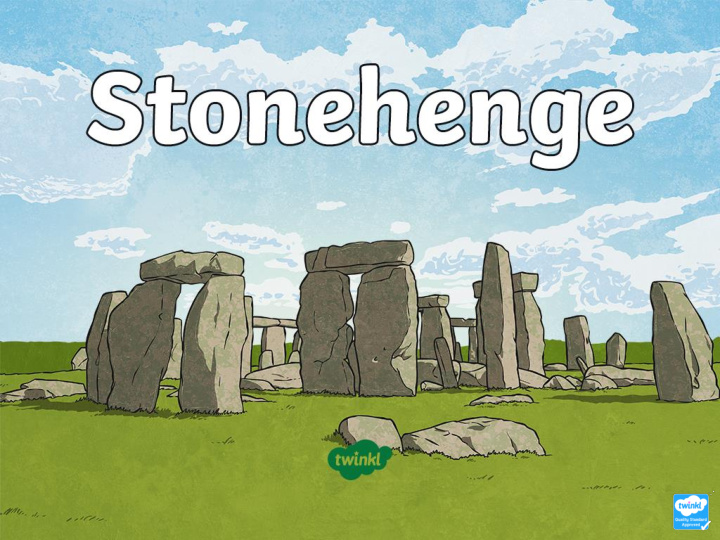



Aim Aim • To identify evidence that supports or refutes scientific theories about Stonehenge. Success Criteria Success Criteria • Statement 1 Lorem ipsum dolor sit amet, consectetur adipiscing elit. • I can discuss why Stonehenge is special. • Statement 2 • I can identify evidence that supports or refutes the theory that Stonehenge was used as an astronomical calendar. • Sub statement • I can explain my own theories, and describe the evidence that supports my ideas.
Stonehenge Stonehenge stands on Salisbury Plain in Wiltshire. It is one of the world's most famous and recognisable monuments, and is estimated to be around 5000 years old!
Features of Stonehenge This is how Stonehenge would have looked around 2000 BC. Outer circle Bluestones The outer circle was made from 30 These are the oldest stones standing stones. A continuous ring of at Stonehenge. They form horizontal stones sat on top of them. one circle inside the outer circle and another inside the horseshoe. Horseshoe Five stone arches make up the horseshoe. These stones are Heel Stone around seven metres high. The Heel Stone stands at the entrance to Stonehenge. Evidence suggests that there was a second Aubrey Holes Heel Stone next to it. A ring of 56 chalk pits has been discovered around the stones. Avenue The avenue leads from the River Avon to Stonehenge, and is the entrance to the monument.
Why Is It Impressive? Look at these facts about Stonehenge. Talk to your partner about which of these facts you consider to be most impressive, and why. It is estimated that the construction of Stonehenge would have taken around 30 million hours of work.
Ideas and Evidence There are many theories about what Stonehenge was for. Some people believe that it was a place of healing for the ancient Britons, while others think the ancient people may have used it for religious ceremonies. Many scientists have studied Stonehenge and have developed scientific theories about what it was used for. By exploring Stonehenge carefully, some scientists believe they have found evidence that it was used as an astronomical clock or calendar. An astronomical calendar tracks the sunrise and sunset over the year, as well as other astronomical occurrences such as eclipses. However, other scientists think that there is not enough evidence to prove this.
Astronomical Calendar This alignment is repeated with the midwinter sunrise. midwinter Midwinter's Day is also known as the Midsummer's Day is also known as winter solstice. This is the day with the the summer solstice. This is the longest shortest period of daylight and the day of the year, marking the end of longest night of the year. Spring and the start of Summer. Some scientists suggest that the site of Stonehenge is arranged so that, on midsummer midsummer , the Sun rises near to the Heel Stone, or between the two Heel Stones, and then shines straight into the centre of the horseshoe.
Astronomical Calendar The midsummer Sun rises over the Heel Stone. If the second Heel Stone still stood, the Sun would rise between them.
Scientists' Theories Many scientists have studied Stonehenge to explore the idea that it could have been used as an astronomical calendar. Some scientists have published evidence that supports this idea, whereas other scientists have found evidence that refutes it. Look at the scientists' evidence on your Scientists' Theories Activity Sheet . Cut out each box of evidence and stick it in one of the columns on your Support or Refute Activity Sheet .
What Do You Think? You have looked at some of the scientists' theories and their evidence for or against the idea that Stonehenge was used as an astronomical calendar. Now it's over to you! What do you think? Could Stonehenge have been used to track astronomical events such as the sunrise and sunset, eclipses or the passing of the year? Talk to your partner about what you think, and the evidence that makes you think this. Does your partner agree with your ideas?
Recommend
More recommend